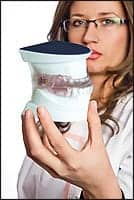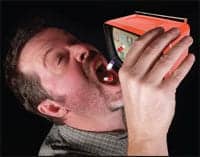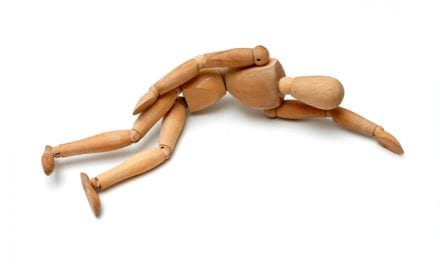 |
| Product image courtesy of SomnoMed, Denton, Tex. |
CPAP is still the gold standard for the treatment of mild to moderate OSA, but there are a number of signs that oral appliances (OAs) are becoming a popular and widely accepted alternative.
More than 2 years ago, the American Academy of Sleep Medicine (AASM) issued its 2005 practice parameters for oral appliance therapy, opening the door for sleep physicians to prescribe OAs as an option for the treatment of mild to moderate OSA.
Of course, CPAP remains the most widely used treatment for OSA, but there are signs that OAs are beginning to gain market share.
Airway Management Inc, Dallas, which designs and markets the popular TAP® line of OA devices, says that business has never been stronger. CEO W. Keith Thornton, DDS, Diplomate, ABDSM, estimates that his company will see a 25% growth in orders from 2006 to 2007.
|
Search Sleep Review’s
|
Another mark of wider recognition and growth is that more insurers are reimbursing patients for OAs—though often they are required to first try CPAP.
Yet another sign of OA progress is that CPAP provider Respironics Inc, Murrysville, Pa, recently introduced the Snore Silencer™ Pro, an adjustable OA that can be fitted chair-side by dentists. Company officials say that Respironics has no plans to abandon PAP technology in favor of OAs, but the news that the company is offering such a product is another indication that OAs have entered the clinical mainstream of sleep apnea treatments.
Finally, sleep laboratories have recognized OAs’ expansion and are increasingly interacting with sleep dentists certified by the American Academy of Dental Sleep Medicine (AADSM) to provide patients with diagnosis and OA therapy.
LARGE SELECTION OF OA DEVICES
Search the Internet for sleep apnea oral appliances, and patients can find a large and diverse selection of OAs. Some are one-size-fits-all devices designed only to treat snoring, while others are custom appliances that are fabricated in dental labs for mild to moderate OSA. According to the AADSM, there are more than 40 OA designs to choose from.
Within those designs, OAs can generally be separated into two types: Mandibular repositioning appliances (MRAs, sometimes known as mandibular advancement appliances) are most often recommended by dental sleep professionals. The second design type is called a tongue-retaining (TR) device.
MRA designs typically use two splints that are custom molded to the patient’s upper and lower teeth. After being fabricated at a dental laboratory, the splints are then locked together with a hinge that is fastened to the sides or back of the splints. Once inserted onto the teeth, the MRA uses the upper jaw as an anchor to extend the lower jaw forward. The advancement clears the airway by moving the tongue forward and tightening the excess tissue in the back of the throat.
Higher-quality MRAs can be customized and adjusted or “titrated” with mechanisms that can shift the lower jaw forward or backward in microincrements, thus preventing the jaw from uncomfortably being protruded too far—or not enough to be effective.
Inexpensive “boil and bite” MRAs are fit to the patient’s dentition by inserting a plastic mold into hot water, temporarily softening the plastic. The patient then bites into the appliance, molding it to the person’s dentition.
While being less expensive, boil and bites are less durable and less accurate for giving patients the optimal level of titration. Consequently, some dentists use boil and bites only when the patient has been diagnosed with snoring, but not sleep apnea. Others use them as trial appliances to see if patients are comfortable with OA therapy. If successful, the dentist then fits the patient for a customized MRA.
Tongue-retaining OAs are comprised of two fused splints with an elastic sleeve or bulb sandwiched between them. The patient inserts their tongue into the sleeve, which holds the tongue in the forward position and prevents it from blocking the air passage. TRs can be quite effective, but also can be uncomfortable because of immobilizing the tongue.
MRAs have dominated the OA field, but dentists may still recommend TRs for patients who wear dentures or have few natural teeth. Solidly implanted teeth are important because MRAs use teeth to anchor the two splints to the jaw and push the lower jaw forward; therefore, cemented dentures or bare gums are too weak to hold the appliance in the mouth.
PREMIUM OA FEATURES
Laura Sheppard is the technical manager at Davis Laboratory, Wyoming, Mich, which creates custom OAs for several leading manufacturers. These include the TAP from Airway Management, the Adjustable PM Positioner™ from Minneapolis-based Dental Services Group, and, starting in 2008, the SomnoMed MAS from SomnoMed, Denton, Tex.
Other popular custom MRA brands are the EMA-custom from Frantz Design Inc, Austin, Tex; the Suad™ Device from Strong Dental Inc, Leamington, Ontario; Klearway™, Vancouver, British Columbia; and The Silencer® Professional from Silencer Products International Inc, Surrey, British Columbia.
Sheppard says that all these appliances are customized to the patient, as well as having some way of incrementally advancing the jaw forward. But she also recommends that sleep dentists look for several other factors when choosing appliances.
“First and foremost, I would be looking for full coverage, or you’re going to get tooth movement or an imbalance of the forces.” An OA with full coverage means that the appliance covers all of the teeth. Some appliances just cover the front teeth, leaving the back teeth exposed and leading to dental complications, such as throwing off the bite.
Second, as mentioned, Sheppard says that the appliance has to be adjustable, and not necessarily just from an anterior to posterior direction. “Ideally, it would be vertically adjustable too, because some patients are better off with more opening than more forward, and vice versa. Every patient is different.”
Third, Sheppard suggests that the OA should be able to be titrated during sleep. The TAP products are notable for this feature because the titration screw is located in the front of the mouth. During sleep, it is therefore easy for the RPSGT to adjust the level of titration without disturbing the patient.
However, Sheppard says that OAs with adjustment devices on the side of the appliance are still relatively easy for an RPSGT to titrate without waking up the patient.
“They are so tired,” she says of OSA patients exhausted from lack of sleep. “So, [an RPSGT] can still go in, open up their cheek, turn a screw, and walk out, and they don’t even notice.”
More cumbersome custom designs force technicians to remove the entire appliance from the patient’s mouth. But these may have other advantages that may be better for the patient, such as a vertical opening or less encroachment on the tongue space.
While Sheppard’s recommended features are general, she points out that one brand of OA—no matter what its features—does not fit all patients. Teeth grinding, the patient’s dentition, tongue space, and having an overbite or an underbite are just a few important factors to consider when choosing a custom OA.
THE DENTIST AND THE SLEEP LABORATORY
The AADSM recommends that its trained and certified member dentists refer all patients suspected of having OSA or SDB to a sleep laboratory for a complete PSG evaluation and, if needed, to return for titration.
Likewise, many sleep laboratories that have noncompliant CPAP patients, or those who want an alternative therapy, will refer those patients to dentists for an OA.
Before referring patients to sleep laboratories, many dentists carry home screening devices. The type of monitoring device can range from basic pulse oximeters that measure desaturation events to a more sophisticated home test that measures respiratory disturbance index and other channels.
Aside from evaluating whether patients need to be referred to a sleep study, some dentists may also provide home devices to patients for monitoring their progress and for self-adjustments.
Despite having home testing devices, Sheppard strongly recommends dentists follow AADSM and AASM guidelines for OAs and refer patients to a sleep laboratory for initial evaluation and follow-up titration. Doing so establishes a working relationship that benefits patients, dentists, and the sleep laboratory.
Of course, whether a dental patient returns to the sleep laboratory for titration largely depends on the patient.
Sheppard says, “A patient quite often will not go back [for a sleep study] because they say they feel better. That’s freedom of choice. They don’t have to go back, but I would certainly have a dentist recommend a follow-up sleep study. That’s how all the best dentists are doing it.”
Tor Valenza is a staff writer for Sleep Review. He can be reached at [email protected].
Respironics and Oral Appliances?
It may seem surprising that one of the leading CPAP providers, Respironics, has entered the sleep oral appliance market with its Snore Silencer Pro, but company officials say that they have no intention of replacing their CPAP products in favor of OAs.
Dave Myers, RRT, global marketing director for diagnostics and clinical software applications, explains, “CPAP is only one particular device to treat SDB. By bringing in the Snore Silencer Pro, it puts us into another channel.”
That channel is the snoring-only patient who comes out of a PSG study without a diagnosis of OSA. Myers says, “We wanted to have this product as an opportunity to make sure that [sleep laboratories] are not sending patients away without an opportunity for treatment.”
Additionally, Respironics hopes to attract CPAP patients who travel or go to places where electrical outlets are hard to find, such as camping trips. “This may be a bridge-gap product that will allow, for a short period of use, an adjunct for positive airway pressure,” says Myers.
The Snore Silencer Pro is a boil and bite-type MRA device. It offers three distinct levels of advancement for titration.
As an accessory to the Snore Silencer Pro, Respironics also is marketing its RUSleeping™ RTS sleep screening device. The package allows dentists to screen patients for SDB and provides guidelines for referring a patient for a full sleep study. If it is negative for OSA, the dentist can then suggest the Snore Silencer Pro for snoring only.
—T.V.
The Right OA: All About the Patient
When new sleep dentists call Laura Sheppard, technical manager at Davis Laboratory, Wyoming, Mich, for advice on what OAs to carry, they often ask about price and popularity, seeking a single appliance for their practice. But Sheppard believes that one appliance does not work for every patient.
She says, “Dentists can’t be brand loyal. They have to be patient loyal. That’s the biggest mistake you see.” Sheppard says that dentists need to be patient loyal because each patient will have unique challenges that may not be fixed by a particular appliance. Whether a person has a class I, II, or III bite can indicate one type of device. Durability may be more important than some other features because the patient is a bruxer.
“If I have a heavy bruxer—someone who’s going to need [their jaw] to move around a lot at night—I’d probably put in an appliance that’s going to allow him some lateral ability. If I’ve got a patient who has a tongue space problem, I might put him in an appliance that has the hardware on the outside.”
A patient’s dental arches are also a factor. “These are all tooth-retaining appliances. If you are a dentureless patient, it’s a little difficult to keep the appliance in your mouth with no teeth. That’s not to say we haven’t made them for a dentureless patient, but you have to have a healthy ridge.”
Once a proper patient assessment is made, a sleep dentist can choose from among three or four brands that may be more appropriate for a particular patient for their dental architecture. Each appliance will also have its own way to adjust for fit, and some brands can provide options for softer linings for better comfort.
—T.V.





